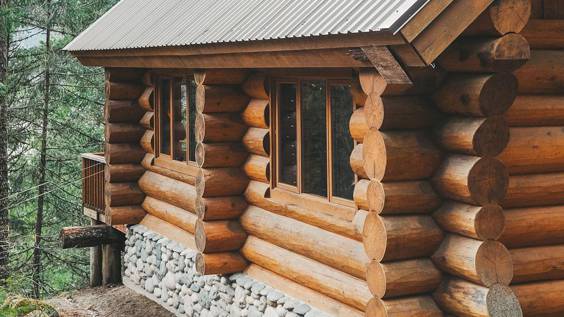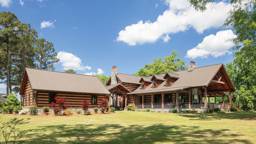
Photo by Alice Davies on Unsplash
The idea that a log home will require excessive maintenance is one of the biggest barriers to owning one. The truth is that any house requires upkeep, whether it’s made from stone, vinyl, brick or wood. When it comes to log homes, the rules are just a little different. Fortunately, there are a few design tricks you can employ to lighten the maintenance load.
1. Start with a smart site.
Log homes are built successfully in all climate conditions, from frosty mountaintops to humid coastlines to windy plains. The key is to properly situate your home on whatever terrain you choose.
Perching your place on the precipice of a mountain or the edge of a canyon will afford dramatic views, but an exposed environment like this will elevate your maintenance requirements. Instead, try to nestle your house into a nook or on the leeward side of a knoll to protect it from hostile weather.
In addition, keep foundation plants, especially shrubs, a few feet away from the structure’s perimeter and ensure they don’t come in contact with the wood, which will allow air to circulate and help the logs stay dry (moisture is log home enemy #1). Ensure tall trees are kept at a distance, too, to help prevent leaves and twigs from accumulating on the roof and in gutters. About 20 feet should do the trick for most tree species.
2. Include deep covered porches.
Outdoor living is synonymous with log homes, so incorporating porches, decks and patios into a layout ranks high on many soon-to-be-homeowners’ must-have lists. However, in an effort to save a little money on materials, the overhangs for these areas can be shortchanged, and the minimal amount of cash that’s saved upfront will be quickly spent on maintenance.
“The fact is, wood that’s kept dry, is properly finished from the start and is protected from the sun can last for many years without touching it,” says Perma-Chink’s Paul Peebles, a stain-and-sealants professional for nearly 30 years.
The answer is simple. Design your porches so that they are a minimumof 8 feet deep (upping this number to 10 feet or more will give you space to spread out) and ensure all roof overhangs around the perimeter of your house are at least 2 to 3 feet deep.
This one strategy can reduce how often you need to re-stain or re-seal your logs, saving you money and boosting your enjoyment.
3. Go a little faux.
It may seem odd, suggesting you put manmade materials next to glorious natural wood, but it can be an excellent low-maintenance tactic for a number of reasons.
For starters, some design elements, like dormers and gables, are easier and less expensive to frame and encase with a product like cement shingles or corrugated metal — both of which accentuate the beauty of the logs, rather than compete with it, according to designer/builder Michael Grant with Modern Rustic Homes in Georgia.
“In addition, you can eliminate the maintenance of these hard-to-reach areas of your home; they never need painting or re-staining,” shares Zach Parmeter with Wisconsin’s Golden Eagle Log Homes.
Encasing the foundation in these kinds of materials is another way to protect your logs from prolonged moisture, though here it’s just as easy to use natural stone, brick or other masonry to keep things nice and dry.
Already living the log home dream? Learn how to keep it in tip-top shape here!










